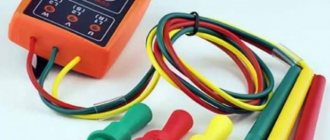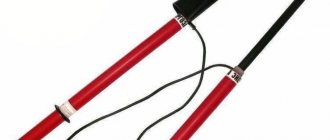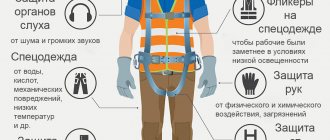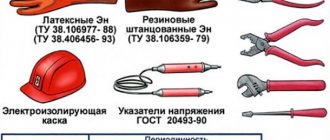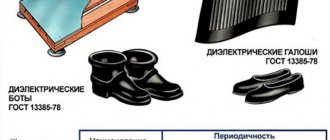Protective means in electrical installations and their types
Maintenance personnel of existing electrical installations are required to use protective equipment recommended by the electrical safety instructions, according to which all protective equipment is divided into two types.
There are different types of protective equipment
Tools and devices of the first group are able to withstand stress for a long time. This group is the main one. The use of fixed assets during work that is carried out without stress relief provides a guarantee that nothing will happen to a person during the period during which he carries out test work or repairs.
Another group includes additional means of protection. They do not provide one hundred percent protection and confidence that an electric shock will not cause an accident, and can only be used together with protective equipment of the first group, that is, with the main ones.
Protective grounding
In electrical installations up to 1000 volts (low voltage) and above 1000 volts, the same protective equipment can be used differently. In one case, it is allowed to be used as a primary means; in power plants over 1000V, this is only an additional protection measure.
The main protective elements include:
- insulating rods;
- voltage indicators;
- electrical and insulating clamps;
- locksmith tools with insulated handles;
- dielectric gloves.
This list is approved for use in power plants up to 1000V.
Note! Dielectric gloves as the main means of protection are allowed to be used only in those electrical installations where the voltage is less than 1000 V. The use of gloves in high-voltage electrical installations as a main means is not permissible!
Locksmith tools must be used with protective gloves
Additional protective measures are:
- dielectric galoshes and boots;
- dielectric mats;
- insulating stands;
- portable protective grounding;
- rods.
There is a division into means for collective and individual use (PPE). The purpose of the latter is to prevent a person from falling from a height, to protect the respiratory organs, to prevent injuries to the head, face, hands, and other parts of the body. This also includes suits that protect against electric arcs.
Important! The timing of PPE inspection is regulated by industry documents and must be observed.
Is it necessary to test new dielectric gloves, boots, galoshes, tools???
We are often asked why test dielectric gloves, because it is easier and cheaper to buy new ones. But it's not that simple. There are rules that must be followed.
INSTRUCTIONS FOR USE AND TESTING OF PROTECTION MEANS USED IN ELECTRICAL INSTALLATIONS WITH 153-34.03.603-2003
1.4.4. Electrical protective equipment, except for insulating stands, dielectric carpets, portable grounding, protective fences, posters and safety signs, as well as safety belts and safety ropes received for operation from manufacturers or warehouses, must be tested according to operational test standards.
Our company’s stationary high-voltage electrical laboratory tests the following protective equipment:
- dielectric gloves;
- rubber dielectric boots and galoshes;
- hand insulating tool;
- insulating rods;
- insulating and electrical clamps;
- voltage indicators;
- insulating stands and caps;
- portable grounding.
After commissioning, PPE and power tools are subject to periodic and extraordinary testing. Extraordinary tests are carried out after repairs, replacement of components, or when a malfunction is detected. All tests of protective equipment made of dielectric rubber , power tools, rods, voltage indicators are carried out in accordance with the document “Rules for the use and testing of protective equipment used in electrical installations, technical requirements for them” and state standards. Before testing, an external inspection is carried out. If any defects are detected or the PPE is incomplete, it is considered faulty and testing is stopped. If the external examination gives a positive result, the product undergoes testing, including control of mechanical and electrical characteristics.
Rules for testing protective equipment in electrical installations
Classification of personal protective equipment
There is a verification methodology approved by government and industry documents. Order of conduct:
- Mechanical tests should be performed before electrical tests.
- All testing work is carried out by employees who have undergone preliminary training and certification. Failure to comply with this requirement is considered a gross violation and entails administrative liability.
- Before inspection, protective equipment must be carefully inspected to identify the manufacturer's mark. The completeness must be complete. Insulating surfaces are checked for the absence of any mechanical damage.
- Electrical tests must be performed with alternating current. The temperature regime must be observed (from plus 25 to minus 15 °C).
- Currents flowing through insulation and voltage indicators up to 1000 V are standardized.
- After electrical testing and parameter measurements, protective equipment made from solid materials is checked by palpation to detect the presence or absence of local heating.
- In case of breakdown or detection of discharges on the surface, exceeding the norms of current values through the test medium, heating, the product is rejected.
Important! It is prohibited to use a product with damage or defects identified during testing.
Products used for electrical safety must be stamped. The stamp marking must include the name of the product, manufacturer, date of manufacture, period of periodic testing.
If there is no stamp or after the verification period has expired, the protective agent cannot be used. The use of such products will be considered a violation of safety regulations with a risk to health.
Procedure for providing workers with PPE
The acquisition process, issuance procedure, rules for use and storage, as well as care for personal protective equipment and safety footwear. Standard standards for issuing PPE. Development of a list of personal protective equipment at the enterprise. Personal cards for recording the issuance of PPE. PPE on duty. Use of personal protective equipment.
***
One of the main standards that define the requirements for the acquisition process, the issuance procedure, the rules for use and storage, as well as the care of PPE, are the Intersectoral Rules for Providing Workers with Work Clothing, Safety Footwear and other PPE, approved by Order of the Ministry of Health and Social Development of Russia dated June 1, 2009 No. 290n.
Workers are provided with PPE in accordance with the standard standards for the free provision of workwear, safety footwear and other personal protective equipment.
There are quite a large number of these norms (about 70), we will not list them all. They are designed for industries or even individual holdings. They are easy to find on the Internet:
For example, .
From all the variety, we need to choose those that are suitable specifically for our production.
In the absence of professions and positions in the relevant standard standards, the employer issues to employees PPE provided for by the standard standards for workers of cross-cutting professions and positions in all sectors of the economy, and in the absence of professions and positions in these standard standards - by the standard standards for workers whose professions (positions) are typical for work performed.
Based on standard issuance standards, the occupational safety specialist develops his own list of PPE.
list of personal protective equipment
Now you need to purchase protective equipment. Purchased PPE must have certificates of conformity or declarations of conformity. Do not purchase PPE for which the certificate or declaration expires. In fact, this will mean that you are using non-certified personal protective equipment.
The procedure for issuing PPE is determined by the relevant regulations.
Regulations on the organization of the issuance and use of special clothing, special footwear and other
personal protective equipment
The issuance and return of PPE is recorded in the employee’s personal card.
Download the form of a personal registration card for the issuance of personal protective equipment
Since 2015, it has been possible to keep records of the issuance of personal protective equipment in electronic form or using special software, but this implies additional requirements for the personification of workers. Which, in our opinion, makes this norm actually stillborn.
PPE issued to workers must be appropriate for their gender, height and size.
The period of wearing PPE is calculated from the day it is issued to the employee.
Workers combining professions are additionally provided with appropriate PPE.
Employees of third-party organizations, when performing work in production shops and areas where there are harmful and (or) hazardous production factors that can affect workers, must be provided with PPE by their employer in accordance with the standard standards provided for employees of relevant professions and positions of the organization, to which they are sent.
PPE on duty
There are protective equipment needs that arise only when carrying out a certain type of work. Such PPE is assigned to certain areas or workplaces and is transferred from shift to shift.
Duty PPE is issued to managers responsible for carrying out these works.
Example. Duty means of protection against electric shock in the switchgear in accordance with the standards for acquisition according to SO 153-34.03.603-2003.
Procedure for using PPE
In addition to the fact that workers must be provided with protective equipment, the employer’s task is to properly instruct workers on how to use them correctly
It is equally important that workers do not forget to use them while performing work. Responsibility for the correct use of PPE lies with the immediate supervisor of the work
Workers must not only be able to put on PPE correctly, but also be able to determine whether it is unsuitable for use.
In addition to inspection before use, protective equipment such as those used against electric shock must undergo periodic verification.
| Dielectric gloves | Before use | Once every 6 months |
| Tool (for insulation) | Before use | Once a year |
| Direction signs (UNN) | Before use | Once a year |
| Insulating pliers | Once a year | Once every 2 years |
Test periods for protective equipment used in electrical installations
Rules for the use of personal protective equipment
The frequency of inspection and testing of protective equipment must not be violated.
Each protective equipment has its own testing period
If the deadlines for checking PPE in existing electrical installations are violated, those responsible for electrical equipment bear administrative responsibility.
The testing procedure for different products differs.
Gloves
Dielectric gloves should be tested once every 6 months. In low-voltage electrical installations they are OSC. In the rest, it is allowed to use it as DZS together with OZS to enhance protection. Gloves should be worn as follows: the bells should cover the sleeves.
Gloves can be single-seam or seamless. Before use, be sure to carry out an external inspection to detect damage, tears, cuts, moisture and dirt.
Important! The presence of these defects reduces the protective properties. The tightness is tested by rolling from the socket to the fingers. During use, it is recommended to wash the product from time to time in a soda or soap solution and then dry it.
Products are tested in water. An electrode is placed in the glove, after which voltage is applied to the metal part of the bath and to the electrode, and the current is monitored with a milliammeter. In case of breakdown or excess current through the glove, the product is rejected.
Glove Test Scheme
Barbells
Insulating rods are used to check the quality of insulation, replace fuses, perform actions with disconnecting devices, measure electrical quantities, apply and remove portable groundings.
The rods are tested under high voltage equal to 40 kV, which is applied to the insulating parts. The frequency is once every 24 months.
Ticks
They are needed to replace safety devices, remove linings, etc. The device is made entirely of dielectric material, sometimes it may have metal jaws. Clamps can be used to measure electrical quantities in low-voltage electrical devices. They have a secondary winding connected to an electrical measuring instrument. The primary may be a bus or a high-voltage wire.
Voltage indicators
A voltage indicator is required to check the presence or absence of voltage in an electrical circuit. The device contains an indicator lamp (LED or neon). Using a light or sound signal, you can obtain information about the presence of current in the circuit.
Clamps and voltage indicators are tested in the same way as rods. Inspection periods: 1 time every 2 years for ticks, signs are checked once a year.
Grounding
Portable grounding connections are needed to ensure the protection of personnel involved in manipulations on live parts of the power plant from induced or mistakenly applied potential after disconnection from the voltage source has occurred. The tests are carried out similarly to the tests of insulating rods described above. It is allowed to check the insulating flexible part in parts or by winding it into coils.
Portable grounding
Dielectric boots, galoshes
Special shoes made of dielectric material are an additional protective means; they can also serve to protect against step voltage in an electrical installation or on an overhead line. They are unsightly in appearance, but when it comes to the safety of people, there is no choice. Before use, it is necessary to inspect the products and assess their integrity.
Important! You cannot have in your arsenal for protection shoes that have damage, tears, cuts and other defects that reduce the dielectric capacity of the material.
The electrical test procedure is the same as for gloves. The only others are the deadlines. Galoshes should be checked once every 12 months, boots - once every 3 years
1. GENERAL PROVISIONS
1.1. PURPOSE AND SCOPE OF APPLICATION OF THE INSTRUCTIONS
1.1.1. This Instruction applies to protective equipment used in electrical installations of organizations, regardless of the form of ownership of organizational and legal forms, individual entrepreneurs, as well as citizen owners of electrical installations with voltages above 1000 V and establishes the classification and list of protective equipment, scope, testing methods and standards, procedure their use and maintenance, as well as standards for equipping production teams with protective equipment for electrical installations.
1.1.2. The main terms and their definitions adopted in the Instructions are given in Table 1.1.
Instructions for labor protection at workplaces must be brought in accordance with these Instructions.
1.1.3. The protective equipment used in electrical installations must meet the requirements
corresponding to the state standard and these Instructions.
1.1.4. When working in electrical installations the following are used:
- means of protection against electric shock (electrical protective equipment);
- means of protection against high-tension electric fields, collective and individual (in electrical installations with voltages of 330 kV and above);
- personal protective equipment (PPE) in accordance with the state standard (protection for the head, eyes and face, hands, respiratory organs, falling from heights, special protective clothing).
Table 1.1
MAIN TERMS ACCEPTED IN THE INSTRUCTIONS AND THEIR DEFINITIONS
| Term | Definition |
| Worker protection means | A product designed to prevent or reduce worker exposure to hazardous and (or) harmful production factors |
| Collective protective equipment | A means of protection that is structurally and (or) functionally connected with the production process, production equipment, premises, building, structure, production site |
| Personal protective equipment | Protective equipment used by one person |
| Electrical protective agent | Electrical shock protection equipment designed to ensure electrical safety |
| Basic insulating electrical protective agent | An insulating electrical protective agent, the insulation of which can withstand the operating voltage of the electrical installation for a long time and which allows you to work on live parts that are energized |
| Additional insulating electrical protective agent | An insulating electrical protective device, which in itself cannot provide protection against electric shock at a given voltage, but complements the main means of protection, and also serves to protect against touch voltage and step voltage |
| Touch voltage | Voltage between two conductive parts or between a conductive part and ground when simultaneously touched by a person |
| Step voltage | Voltage between two points on the surface of the earth, at a distance of 1 m from one another, which is taken to be equal to the length of a person’s step |
| Safe distance | The smallest permissible distance between the worker and the source of danger necessary to ensure the safety of the worker |
| Voltage indicator | A device for determining the presence or absence of voltage on live parts of electrical installations |
| Voltage indicator | A device for warning personnel about being in a potentially dangerous area due to approaching live parts that are energized at a dangerous distance or for a preliminary (approximate) assessment of the presence of voltage on live parts of electrical installations at distances between them and the worker that significantly exceed safe ones |
| Work without stress relief | Work performed by touching live parts that are energized (active or live), or at distances from these live parts that are less than permissible |
| Electric field influence zone | Space in which the electric field strength of industrial frequency exceeds 5 kV/m |
| Safety poster (sign) | A colorographic image of a certain geometric shape using signal and contrasting colors, graphic symbols and (or) explanatory inscriptions, intended to warn people about immediate or possible danger, prohibit, order or permit certain actions, as well as for information about the location of objects and means, use which eliminates or reduces the impact of hazardous and (or) harmful factors |
| Undistorted electric field strength | The electric field strength, not distorted by the presence of a person and a measuring device, determined in the area where a person will be located during work |
| Shielding device | A means of collective protection that reduces the electric field strength at workplaces in electrical installations under voltage |
1.1.5. Electrical protective equipment includes:
- insulating rods of all types;
- insulating pliers;
- voltage indicators;
- individual and stationary voltage indicators;
- devices and devices to ensure the safety of work during measurements and tests in electrical installations (voltage indicators for checking phase coincidence, electrical clamps, devices for piercing cables);
- dielectric gloves, galoshes, boots;
- dielectric carpets and insulating supports;
- protective fences (boards and screens);
- insulating linings and caps;
- hand insulating tool;
- portable grounding;
- safety posters and signs;
- special protective equipment, insulating devices and devices for work under voltage in electrical installations with voltages of 110 kV and higher;
- flexible insulating coatings and linings for live work in electrical installations with voltages up to 1000 V;
- insulating fiberglass ladders and stepladders.
1.1.6. Insulating electrical protective equipment is divided into basic and additional.
The main insulating electrical protective equipment for electrical installations with voltages above 1000 V include:
- insulating rods of all types;
- insulating pliers;
- voltage indicators;
- devices and devices to ensure the safety of work during measurements and tests in electrical installations (voltage indicators for checking phase coincidence, electrical clamps, devices for puncturing cables, etc.);
- special protective equipment, insulating devices and devices for work under voltage in electrical installations with voltages of 110 kV and higher (except for rods for transfer and potential equalization).
Additional insulating electrical protective equipment for electrical installations with voltages above 1000 V include:
- dielectric gloves and boots;
- dielectric carpets and insulating supports;
- insulating caps and linings;
- rods for transferring and leveling potential;
- ladders, insulating fiberglass stepladders.
The main insulating electrical protective equipment for electrical installations with voltages up to 1000 V include:
- insulating rods of all types;
- insulating pliers;
- voltage indicators;
- electrical clamps;
- dielectric gloves;
- hand insulating tool.
Additional insulating electrical protective equipment for electrical installations with voltages up to 1000 V include:
- dielectric galoshes;
- dielectric carpets and insulating supports;
- insulating caps, coverings and linings;
- ladders, insulating fiberglass stepladders.
1.1.7. The means of protection against high-intensity electric fields include individual shielding kits for work on the potential of an overhead power line (OHT) wire and on the ground potential in an open switchgear (OSD) and on an overhead line, as well as removable and portable shielding devices and safety posters.
1.1.8. In addition to the listed protective equipment, the following personal protective equipment is used in electrical installations:
- head protection equipment (protective helmets);
- eye and face protection (goggles and protective shields);
- respiratory protection equipment (gas masks and respirators);
- hand protection (mittens);
- fall protection equipment (safety belts and safety ropes);
- special protective clothing (electric arc protection kits).
1.1.9. The selection of the necessary electrical protective equipment, means of protection against high-intensity electric fields and personal protective equipment is regulated by this Instruction, Interindustry rules for labor protection (safety rules) for the operation of electrical installations, sanitary standards and rules for performing work in conditions of exposure to electric fields of industrial frequency, guidelines for protection of personnel from exposure to electric fields and other relevant regulatory and technical documents taking into account local conditions.
When choosing specific types of PPE, you should use the appropriate catalogs and recommendations for their use.
1.1.10. When using basic insulating electrical protective equipment, it is sufficient to use one additional one, except in special cases.
If it is necessary to protect someone working from step voltage, dielectric boots or galoshes can be used without basic protective equipment.
1.2. PROCEDURE AND GENERAL RULES FOR THE USE OF PROTECTIVE MEANS
1.2.1. Personnel carrying out work in electrical installations must be provided with all necessary protective equipment, trained in the rules of use and must use them to ensure the safety of work.
Protective equipment must be located as inventory in the premises of electrical installations or be included in the inventory of field teams. Protective equipment may also be issued for individual use.
1.2.2. When working, you should use only protective equipment that is marked with the manufacturer, name or type of product and year of manufacture, as well as a test stamp.
1.2.3. Inventory protective equipment is distributed between facilities (electrical installations) and between field teams in accordance with the operating system, local conditions and acquisition standards.
Such distribution, indicating the storage locations of protective equipment, must be recorded in lists approved by the technical manager of the organization or the employee responsible for electrical equipment.
1.2.4. If the unsuitability of protective equipment is discovered, they are subject to confiscation. An entry about the seizure of unsuitable protective equipment must be made in the logbook for recording and maintaining the protective equipment or in operational documentation.
1.2.5. Workers who have received protective equipment for individual use are responsible for their correct use and timely monitoring of their condition.
1.2.6. Insulating electrical protective equipment should be used only for their intended purpose in electrical installations with a voltage not higher than that for which they are designed (the highest permissible operating voltage), in accordance with the operating manuals, instructions, passports, etc. for specific means of protection.
1.2.7. Insulating electrical protective equipment is designed for use in closed electrical installations, and in open electrical installations - only in dry weather. They are not allowed to be used in drizzle or precipitation.
Outdoors in wet weather, only protective equipment of a special design designed to work in such conditions should be used. Such protective equipment is manufactured, tested and used in accordance with specifications and instructions.
1.2.8. Before each use of the protective equipment, personnel are required to check its serviceability, the absence of external damage and contamination, and also check the expiration date on the stamp.
It is not allowed to use protective equipment that has expired.
1.2.9. When using electrical protective equipment, it is not allowed to touch their working part, as well as the insulating part behind the restrictive ring or stop.
1.3. PROCEDURE FOR STORING PROTECTIVE EQUIPMENT
1.3.1. Protective equipment must be stored and transported under conditions that ensure their serviceability and suitability for use; they must be protected from mechanical damage, contamination and moisture.
1.3.2. Protective equipment must be stored indoors.
1.3.3. Protective equipment made of rubber and polymer materials that are in use should be stored in cabinets, on racks, shelves, separately from tools and other protective equipment. They must be protected from acids, alkalis, oils, gasoline and other destructive substances, as well as from direct exposure to sunlight and heat radiation from heating devices (no closer than 1 m from them).
Protective equipment made of rubber and polymeric materials that are in use must not be stored in bulk (haphazardly), in bags, boxes, etc.
Protective equipment made of rubber and polymeric materials that are in stock must be stored in a dry room at a temperature of (0-30) °C.
1.3.4. Insulating rods, clamps and voltage indicators above 1000 V should be stored in conditions that prevent them from bending or coming into contact with walls.
1.3.5. Respiratory protection equipment must be stored in dry rooms in special bags.
1.3.6. Protective equipment, insulating devices and devices for working under voltage should be kept in a dry, ventilated area.
1.3.7. Shielding protective equipment should be stored separately from electrical protective equipment.
Individual shielding kits are stored in special cabinets: workwear is on hangers, and safety shoes, head, face and hand protection are on shelves. During storage, they must be protected from moisture and aggressive environments.
1.3.8. Protective equipment used by field teams or for individual use by personnel must be stored in boxes, bags or cases separately from other tools.
1.3.9. Protective equipment is placed in specially equipped places, as a rule, at the entrance to the premises, as well as on control panels. Storage areas must have lists of protective equipment. Storage areas must be equipped with hooks or brackets for rods, insulating clamps, portable grounding, safety posters, as well as cabinets, racks, etc. for other means of protection.
1.4. ACCOUNTING OF PROTECTION MEANS AND CONTROL OF THEIR CONDITION
1.4.1. All electrical protective equipment and personal protective equipment in use must be numbered, with the exception of protective helmets, dielectric carpets, insulating stands, safety posters, protective fences, and rods for transferring and potential equalization. Serial numbers may be used.
Numbering is established separately for each type of protective equipment, taking into account the adopted operating system and local conditions.
The inventory number is usually applied directly to the protective equipment with paint or stamped on metal parts. It is also possible to apply a number to a special tag attached to the protective equipment.
If the protective equipment consists of several parts, a common number for it must be placed on each part.
1.4.2. In departments of enterprises and organizations, it is necessary to keep logs of records and maintenance of protective equipment.
Personal protective equipment issued for individual use must also be recorded in a journal.
1.4.3. The presence and condition of protective equipment is checked by periodic inspection, which is carried out at least once every 6 months. (for portable groundings - at least once every 3 months) by the employee responsible for their condition, recording the inspection results in a journal.
1.4.4. Electrical protective equipment, except for insulating stands, dielectric carpets, portable grounding, protective fences, posters and safety signs, as well as safety belts and safety ropes received for operation from manufacturers or warehouses, must be tested according to operational test standards.
1.4.5. Protective equipment that has passed the test, the use of which depends on the voltage of the electrical installation, is stamped with the following form:
For protective equipment, the use of which does not depend on the voltage of the electrical installation (dielectric gloves, galoshes, boots, etc.), a stamp of the following form is placed:
The stamp must be clearly visible. It should be permanently painted or adhered to the insulating portion near the boundary ring of insulating electrical protective equipment and live devices or at the edge of rubber products and safety devices. If the protective equipment consists of several parts, the stamp is placed on only one part. The method of applying the stamp and its dimensions should not impair the insulating characteristics of protective equipment.
When testing dielectric gloves, overshoes and overshoes, markings must be made according to their protective properties Ev and En, if the factory marking is lost.
On protective equipment that did not pass the test, the stamp must be crossed out with red paint.
Insulated tools, voltage indicators up to 1000 V, as well as safety belts and safety ropes may be marked using accessible means.
1.4.6. The results of operational tests of protective equipment are recorded in special journals. In addition, test reports must be issued for protective equipment owned by third parties.
1.5. GENERAL RULES FOR TESTING PROTECTIVE MEANS
1.5.1. Acceptance, periodic and type tests are carried out at the manufacturer according to the standards given in Appendices 4 and 5, and the methods set out in the relevant standards or technical specifications.
1.5.2. In operation, protective equipment is subjected to regular and extraordinary operational tests (after a fall, repair, replacement of any parts, if there are signs of malfunction). The standards for operational tests and the timing of their implementation are given in Appendices 6 and 7.
1.5.3. Tests are carried out according to approved methods (instructions).
Mechanical tests are carried out before electrical tests.
1.5.4. All testing of protective equipment must be carried out by specially trained and certified personnel.
1.5.5. Before testing, each protective equipment must be carefully inspected to check the presence of manufacturer's markings, numbers, completeness, absence of mechanical damage, and the condition of insulating surfaces (for insulating protective equipment). If the protective equipment does not comply with the requirements of this Instruction, tests are not carried out until the identified deficiencies are eliminated.
1.5.6. Electrical tests should be carried out with alternating current of industrial frequency, as a rule, at a temperature of plus (25±15) °C.
Electrical tests of insulating rods, voltage indicators, voltage indicators for checking phase coincidence, insulating and electrical clamps should begin with checking the dielectric strength of the insulation.
The rate of voltage rise to 1/3 of the test voltage can be arbitrary (a voltage equal to the specified voltage can be applied by a push); further increase in voltage should be smooth and fast, but allowing the readings of the measuring device to be read at a voltage of more than 3/4 of the test voltage. After reaching the rated value and holding at this value for a rated time, the voltage must be smoothly and quickly reduced to zero or to a value not exceeding 1/3 of the test voltage, after which the voltage is turned off.
1.5.7. The test voltage is applied to the insulating part of the protective equipment. In the absence of an appropriate voltage source for testing entire insulating rods, insulating parts of voltage indicators and voltage indicators for checking phase coincidence, etc. It is allowed to test them in parts. In this case, the insulating part is divided into sections to which a part of the normalized full test voltage is applied, proportional to the length of the section and increased by 20%.
1.5.8. Basic insulating electrical protective equipment intended for electrical installations with voltages above 1 to 35 kV inclusive are tested with a voltage equal to 3 times the linear voltage, but not lower than 40 kV, and those intended for electrical installations with voltages of 110 kV and above - equal to 3 times the phase voltage.
Additional insulating electrical protective equipment is tested by voltage according to the standards specified in Appendices 5 and 7.
1.5.9. The duration of application of the full test voltage is usually 1 min. for insulating protective equipment up to 1000 V and for insulation made of elastic materials and porcelain and 5 min. — for insulation from layered dielectrics.
For specific protective equipment and working parts, the duration of application of the test voltage is given in Appendices 5 and 7.
1.5.10. Currents flowing through the insulation of products are standardized for electrical protective equipment made of rubber and elastic polymer materials and insulating devices for live work. Operating currents flowing through voltage indicators up to 1000 V are also standardized.
Current values are given in Appendices 5 and 7.
1.5.11. Breakdown, flashover, and surface discharges are determined by turning off the testing facility during testing, by readings from measuring instruments, and visually.
1.5.12. Electrical protective equipment made of solid materials should be checked by touch immediately after testing for the absence of local heating due to dielectric losses.
1.5.13. If a breakdown, flashover or surface discharge occurs, the current through the product increases above the rated value, or in the presence of local heating, the protective equipment is rejected.
Testing of dielectric gloves
Testing of dielectric gloves
The main electrical protective equipment when working in electrical installations up to 1000 V and additional in electrical installations above 1000 V are dielectric gloves . It is acceptable to use gloves made of natural rubber and sheet rubber no shorter than 350 mm. The frequency of testing dielectric gloves is established in the “Rules” and is once every 6 months . Dielectric gloves undergo only electrical tests, during which the magnitude of the current passing through them (no more than 6 mA) and the absence of breakdown are determined. The testing period for dielectric gloves does not change even if the product has not been in use.

